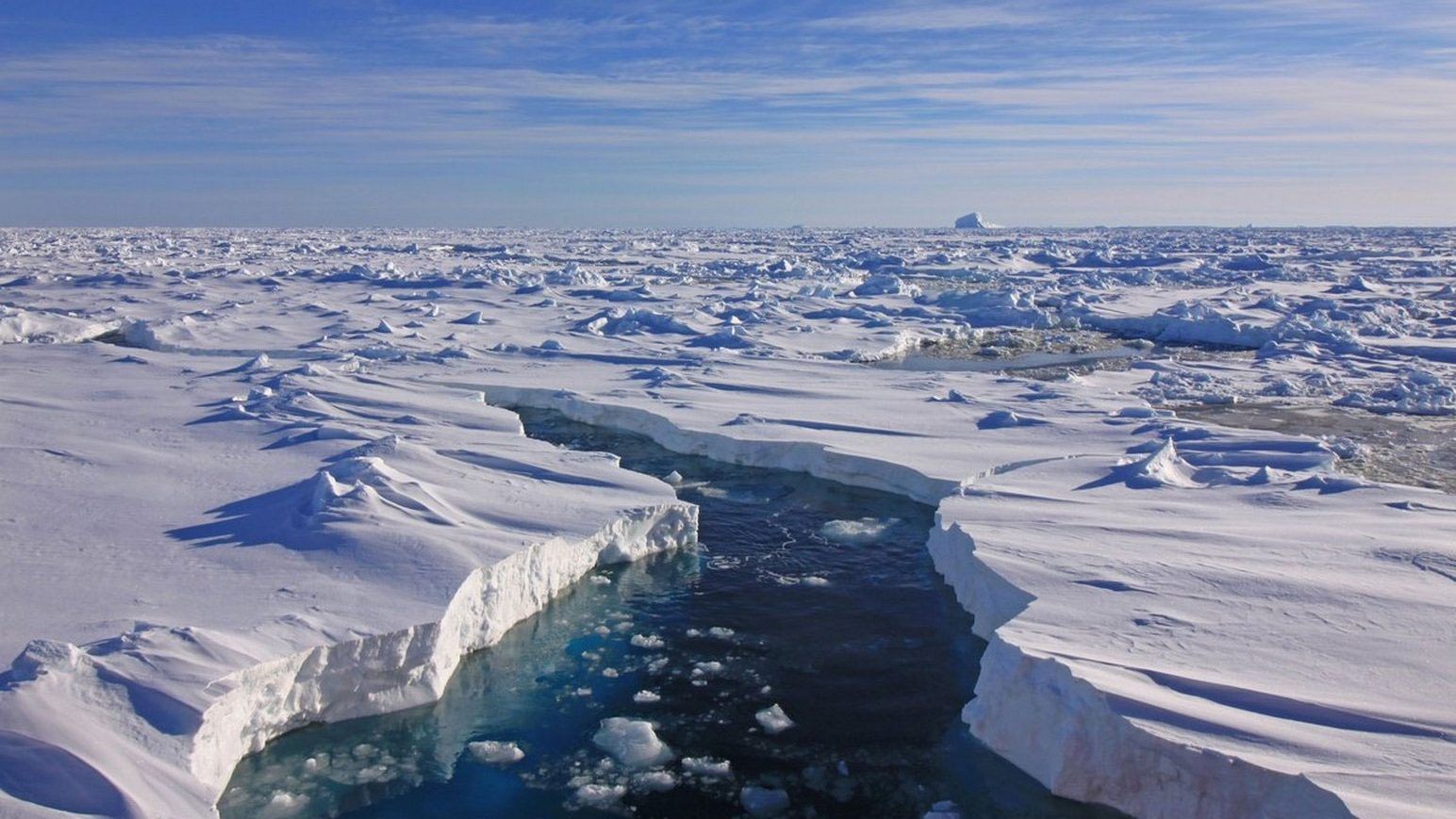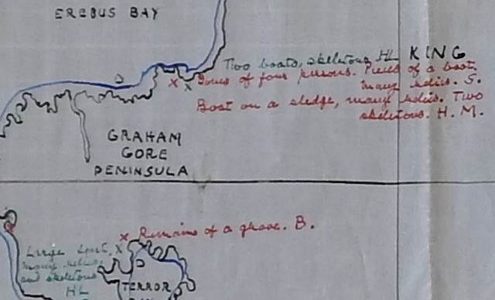Inuit Tales of Terror: The location of Franklin’s missing ship
© David C. Woodman 2016
The discovery of the wreck of the Franklin expedition vessel H.M.S. Erebus in September 2014 garnered worldwide attention and well-deserved praise for the skill and perseverance of the Parks Canada-led team that discovered it. It was universally attested that the preserved nineteenth-century traditions of the Inuit inhabitants of the area were essential in the discovery, providing through their remembrances the search area in which the wreck was eventually located.
This summer, the same team will return to the arctic in continuing pursuit of Franklin’s other ship – H.M.S. Terror – however, surprisingly, very little consideration is being given to the clues embedded in the same traditional narratives about the location of that second vessel. This article attempts to investigate the reasons for this and re-evaluates the Inuit testimony for any clues that could lead to the discovery of this second significant shipwreck.
The Inuit testimony concerning the wreck of H.M.S. Erebus was reasonably consistent, if not entirely straightforward. Two known geographical features were repeatedly mentioned concerning that shipwreck, Grant Point and O’Reilly Island, in an area west of the Adelaide Peninsula called “Utjulik.” As these two points were approximately twenty-five kilometres apart, this still left a very large and daunting area to search. It was only after decades of painstaking effort by a succession of teams that the prize was attained. As it turned out, the wreck was found almost halfway between the two points. Perhaps even more impressive is that the details of the wreck, lying upright, in shallow water, and nearly intact, are totally in accord with the Inuit descriptions given.
In contrast, the geographical clues regarding the location of H.M.S. Terror are almost non-existent. The Inuit testimony collected in the nineteenth century consistently remembered two shipwrecks, the one at Utjulik, the other vaguely referred to as generally lying to the west of King William Island, an island larger than Jamaica. Fifty years after the event, Amundsen, without offering evidence, concluded that the second wreck “had been crushed by the ice on the north side of the Royal Geographical Society Islands.” Clearly, any case setting out a search area based on testimony will not rely on specific geographical clues but must be entirely circumstantial, based not on a particular identified location but on a chain of reasoning from testimony concerning other aspects of the Franklin tragedy.
The clues that could lead to the location of the Terror are primarily embedded in longer stories that involve the visits claimed to have been made by various Inuit hunters to Franklin’s ships while their crews still manned them. Most historians either doubt that these visits occurred or conclude that they refer to the period before April 1848, when the ships were still together off the northwest shore of King William Island.
This reconstruction relies heavily on the only documentary evidence left by the Franklin expedition– a short note recovered from a campsite known as the “Victory Point record.” That note confirmed that both ships, “H.M. ships’ Terror’ and ‘Erebus’ were deserted on the Apr. 22nd, 5 leagues N.N.W. of this” but made no mention of any contact with Inuit before that date. The note itself, an unplanned addendum to an earlier record, could easily be forgiven for omitting such details. However, there are other reasons to doubt that a native visit to the ships before that time occurred.
This idea is seemingly reinforced by the consideration, evident to Sir Leopold McClintock in 1859, the discoverer of that record, that “no part of the coast between Cape Felix and Cape Crozier has been visited by Esquimaux since the fatal march of the lost crews … none of the cairns or numerous articles strewed about – which would be invaluable to the natives – or even drift-wood we noticed, had been touched by them.”
This, too, was confirmed by Inuit testimony that explicitly stated that they had no idea that the Franklin expedition had left relics on the northwest coast until told of it by the natives of Bellot Strait. When McClintock’s exploring parties returned to the ship, these Inuit themselves learned of it. The Victory Point record also indicated that the entire 105 surviving crew abandoned the vessels, presumably intact, in April 1848. Most historians conclude that no one returned but that they all succumbed within a few months on a futile death march toward the south. Therefore it is supposed that the two abandoned ships would have been at the mercy of the prevalent ice drift. The current search for the Terror has concentrated on the known ice-drift patterns from the known location of the abandonment off the northwest coast of King William Island to the area, over two hundred kilometres to the south, where the Erebus was found.
But voluminous Inuit testimony casts doubt on this standard scenario. Inuit stories of their discovery of the Erebus have so far proven to be entirely in accord with what has been found. They are reliable in affirming that that ship was manned when first seen. There were tracks of Franklin’s men in the surrounding snow, and at least one crewman was found dead in the ship when a hunting party penetrated it before sinking. Discovery of evidence of living crew aboard before the sinking is one of the primary goals, along with further possible documentation, of the continuing effort to explore and analyze the wreck.
Considering the verified accuracy of other traditions concerning the Utjulik wreck, the presence of living crew when it arrived in the south must be taken seriously. This single consideration places in doubt the contention that the other ship, the Terror, must lie on the typical drift path from the 1848 abandonment position. Should human remains be found aboard the Erebus, as indicated in the Inuit testimony, there would be irrefutable evidence confirming a re-manning of the ships by at least a portion of the crew. This allows consideration that the proposed visits to manned ships by Inuit hunters could post-date the 1848 abandonment, and have occurred elsewhere.
In fact, testimony emerged from the arctic long before the Victory Point record was discovered, indicating that Franklin’s two ships were not only intact but still manned in 1849. That year the Master of the whaler Chieftain was visited by an Inuk hunter who indicated that two ships had been “frozen up for four years on the west side of Prince Regent Inlet … [he] and some companions had been on board … the previous spring and they were safe.”
This tale would be consistent with other Inuit testimonies that implied their contact with the Franklin expedition post-dated 1848. When referring to native visits to the manned ships, it was recalled that “the two winters the two ships were [beset] were very cold. The Innuits never knew such very cold weather – there was no summer between the two winters.” At the same time, another tale spoke of visits during “the first summer and first winter,” a phrase that also implied an extended interaction. Two “winters” of contact before the ships were finally abandoned, i.e., 1848-9 and 1849-50, would imply that the second attempt at abandonment took place in 1850. That too was seemingly confirmed in 1854 when John Rae, the first to learn the location of the disaster and to return some Franklin relics to England, was told that a party of hunters had met the retreating Franklin crew “four winters ago.”
All of these considerations set a new timeline, one asserting that the ships were at least partially remanned after an abortive 1848 abandonment and either drifted or were taken to some other location where the Inuit hunters found them in 1849.
The investigator who collected most of the relevant testimony was Charles Francis Hall, who spent five years between 1864 and 1869 living with the Inuit and listening to their tales of Kodlunak (European) visitors. He heard many accounts of native visits to explorers’ ships, although it is true that it is difficult to determine which expedition is being referred to in many cases. Most encounters have similarities, as the explorers came in similar ships and used similar technology. The Inuit even gave their commanders common nicknames – Toolooah and Aglooka. In many cases, incidents can be confidently attributed to the correct expedition through internal details or comparison with the explorer’s own accounts. Still, in others, one must look for diagnostic details.
Hall was informed by a hunter named Neewikeetoo that he “as well as other Innuits visited the ship or ships & saw the Koblunas aboard … Most of the Innuits in that part of the country & neighbourhood visited the ship or ships & afterwards moved far from there. After this one Innuit went alone to the ship or ships. This was before the ship or ships was crushed in the ice.”
Neewikeetoo also showed Hall a watch recovered from a Franklin encampment. He said, “he took the watch off the dead body of a Kob-lu-na that was lying under the boat. This was on a large island not very far from Neitch-il-le. The Kob-lu-nas & the boat came from a ship that was crushed in the ice. Before hard times came upon the Kob-lu-nas the Innuits saw the ship or ships.”
On Apr. 13th, 1866, Hall was told by Nood-loo-ong about one Inuk in particular who would often “tell long interesting stories about the ships he had seen … & of the white people aboard … This Innuits name Kok-lee-ar-nung … Kok-lee-ar-nung & many other Innuits saw Aglooka (Crozier) & many other whites while on board the ship or ships.” The recurring seeming confusion within the stories as to whether there were one or more ships will be explained shortly.
Nood-loo-ong affirmed that “Kok-er-ling-arn however did see Aglooka & many other Koblunas on board of the ship many times.” Kokleearngnun was repeatedly interviewed by Hall, and provided the most detailed accounts of a visit to this ship. As proof of his verisimilitude, he “showed two spoons which had been given to him by Ag-loo-ka (Crozier), one of them having the initials F.R.M.C. [Francis Rawdon Moira Crozier] stamped upon it.”
According to the native recollections the interaction with the crews had been prolonged as the Inuit “had their tupiks on the ice alongside of him during the spring and summer.” There had been a large joint caribou hunt “killing so many that they made a line across the whole bay.” It must be admitted that Hall himself had doubts about this testimony. He remarked that “after hearing the story of old Kokleearngnun … I believed they had visited many times Sir John Franklin’s ships while beset in the ice near King William’s Land and there met him, Crozier and all their Company. It took something like three days while encamped on the ice … to find out the fact that all the old man and wife had told me was of Captain and Commander Ross.”
This conclusion disregards many of the details of Kokleearngnun’s story – the Rosses had only one ship, never conducted a joint hunt, and their interaction with the Inuit as described in their own narratives was brief and confined to one year. Kokleearngnun specifically stated that there were “three ships in all – that is one they know about not far from Ook-kee-bee-jee-lua (Pelly Bay) just beyond Cape Barens [Ross’ Victory] & beyond the westward of Neit-tee-lik, [two more] near Ookgoo-lik.” That the old man knew of the various expeditions and was referring respectively to Ross’ Victory and Franklin’s Erebus and Terror seems beyond question, even though Hall may have been told a third-hand mixed version of visits to white men incorporating elements of both Ross and Franklin.
Another remembrance of the visits to the ships in the ice gives another diagnostic detail – the detail of its demise. Kokleearngnun also told Hall of the destruction of one of the two ships “the old man and his wife agreed in saying that the ship … was overwhelmed with heavy ice in the spring of the year. While the ice was slowly crushing it, the men all worked for their lives in getting out provisions; but, before they could save much, the ice turned the vessel down on its side, crushing the masts and breaking a hole in her bottom and so overwhelming her that she sank at once, and had never been seen again. Several men at work in her could not get out in time and were carried down with her and drowned.”
The eminent historian R.J. Cyriax clearly recognized the difficulties presented by the details of Kokleearngnun’s stories, reluctantly admitting that “some of the officers and men may have returned to the ships after the 1848 attempt to reach the Great Fish River” and “a catastrophe like the one described by Kokleearngnun may have taken place afterwards.” However, he nevertheless concluded that “nothing in his statement warrants so free an interpretation.”
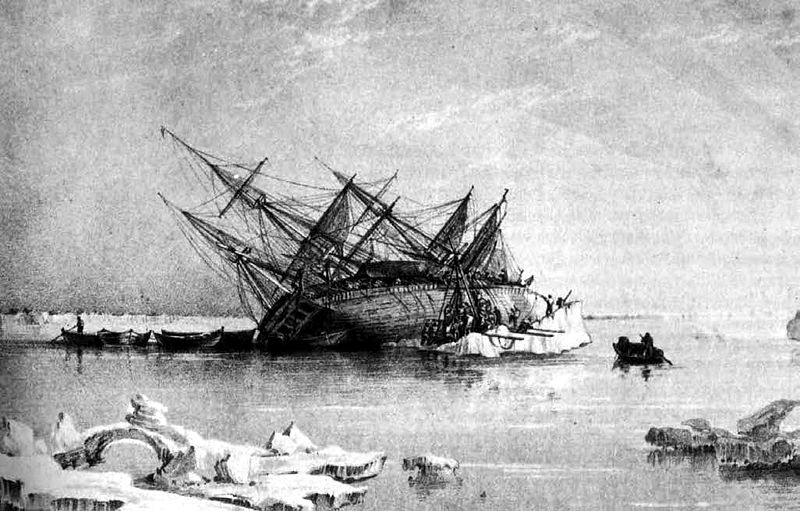
This opinion disregards the fact that Sir Leopold McClintock, who never met Kokleearngnun, had been informed ten years before Hall by the Inuit at Bellot Strait that “the natives had seen two ships of King William’s Land.” One of these “was seen to sink in deep water” Another hunter added the helpful detail that the ship “had been crushed by the ice out in the sea west of King William’s Island.” He informed McClintock’s interpreter Petersen that “he was not one of those who were eye-witnesses of it” tacitly implying that other Inuit were.
It follows that the dramatic crushing and sinking of the Terror (for it is now known that the Erebus sank upright, gently and intact) that was reported to McClintock must post-date the 1848 abandonment, as it surely would have been indicated in the Victory Point record. This partially validates the 1849 account of a visit to Franklin’s two ships and is in accord with many other Inuit stories about visits to the Franklin expedition before they met their ultimate fate.
The destruction of the Terror by being crushed in the ice and quickly destroyed was not only described by various Inuit witnesses but also by the survivors of Franklin’s expedition themselves. In Washington Bay, a party of Franklin’s men was encountered on the march by a party of hunters. The stories told of this encounter, relayed at different times by almost every person involved, are so detailed and consistent that they are regularly mentioned in every history of the expedition and are believed to be an accurate account. Although usually attributed to the 1848 march, the details almost universally contradict the idea of a single 1848 retreat from the ships. One of the more dramatic details involves the description by the leader of the retreating contingent of a dramatic sinking “[he] made a motion to the northward & spoke the word oo-me-en, making them to understand there were 2 ships in that direction; which had, as they supposed, been crushed in the ice. As [he] pointed to the N., drawing his hand & arm from that direction he slowly moved his body in a falling direction and all at once dropped his head side ways into his hand, at the same time making a kind of combination of whirring, buzzing & wind blowing noise. This the pantomimic representation of ships being crushed in the ice.”
Again traditional historians were skeptical of the Inuit story. Cyriax, an honest scholar who struggled with his bias against the oral traditions, remarked, “the officers commanding the main body are most unlikely to have known what happened to the ships since their departure from them. It thus seems evident that if the natives did conclude, in consequence of what the white men tried to explain, that a ship had sunk, they misunderstood what their informants tried to describe. I admit that more than one attempt to escape may have been made and that Eskimos may have met white men after a ship had sunk, but there is no evidence for such an occurrence.”
Cyriax’s contention here is that there is no physical evidence that supports multiple attempts at abandonment. However, as shown above, there is ample evidence in the Inuit testimony. One other curious detail of the Inuit remembrances practically clinches the argument as to which ships were the actual source of the above stories.
The white commander of the visited ships was known as “Aglooka” (strider) to the Inuit. This was a common and widely-bestowed native nickname for a European commander. We know that during the Parry sojourn at Igloolik in 1822, midshipman Crozier, who would later be Franklin’s second in command and Captain of the Terror, had exchanged names with a small boy named Aglooka. Over forty years later, Hall interviewed the adult Aglooka, now known as “Crozier.” Although suggestive of the fact that Crozier was known as Aglooka (Ross, in comparison, was consistently called Toolooah – Raven), the nickname given to the commander of the visited ships is not conclusive.
What does seem conclusive is that Hall’s informants “all of the Pelly Bay Inuit knew of “Cro-zhar,” who had been an “Esh-emut-to-nar (mate or some officer not so great as captain on Parry’s ship).” They were also aware that the “same man, Crozier, who was at Igloo-lik when Parry and Lyon were there, was Esh-e-mu-ta (meaning captain in this case, the literal chief) of the two ships lost in the ice at Neitchille.”
This accurate thumbnail biographical sketch could only have come from Crozier himself! The fact that the natives knew that Crozier had served with both Parry and Franklin is remarkable enough; they learned this from Crozier’s own lips, while he served as “eshemuta” of the two ships in the ice, is, remarkable.
One old woman spoke of her nephew who “had seen Eg-loo-ka who was Esh-e-mut-ta (Chief or Captain) before – one year before on board of his ship … Her nephew went to this ship on the ice in company of many other Innuits. After this visit to this ship, the Neitch-il-lee Innuits believed that the ship had gone away – gone home to the Kob-lu-na country; but the first they heard was that a great many Kob-lu-nas had frozen & starved to death.”
That Crozier was in command does not preclude the possibility of a pre-1848 visit to the ships for one of the definitive facts contained in the Victory Point record informs us that he had assumed command of the expedition after Franklin’s death on June 11th 1847. Again we are faced not only with the fact that the Inuit did not know of the presence of the ships on the northwest coast. As Cyriax remarked, “had any Eskimos visited the ships near that coast before the retreat to the Great Fish River … they would almost certainly have returned to the northwest coast during the next few years to see whether the white men had left behind anything worth taking away.”
This consideration is a powerful clue as to when and where the Inuit believed the ships first came to their land. After Franklin’s last men succumbed, the Inuit found a trail of skeletons and campsites leading along the southern shore of King William Island. As they followed this trail to the west they came across a significant location on the west coast in modern Erebus Bay where they found two boats on shore and the cannibalized remains of some of Franklin’s unfortunate crew. In modern times this has been called the “boat place” (archaeologically Ngli-2 at 69° 08’ 30 “N 99° 02’ 17 “W). And then they stopped looking.
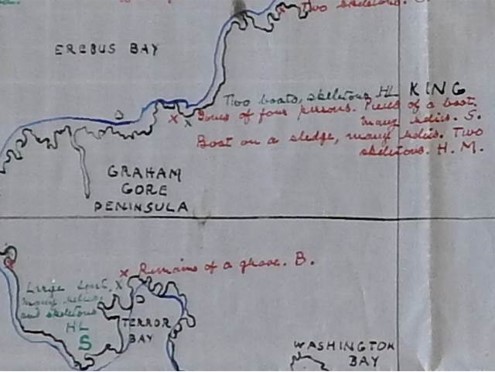
Why did the Inuit not continue to the north, where a wealth of Franklin relics awaited them? Perhaps the clue lies in another story, told by the old woman Ookbarloo, about the sinking of the second ship. Ookbarloo noted that “nearly the whole of one side of the vessel had been crushed in by the heavy ice that was about it.” She thought this was why “the Kob-lu-nas had left it and gone to the land and lived in tents.”
Living ashore in tents would have been a sensible course of action after one of the ships had been nipped. The Erebus and Terror were not large vessels, barely over 30m long, and would have been uncomfortably cramped for two crews. Once the Terror was wrecked, it would be sensible, at least during the short summer season, to take any surviving material salvaged from her, including her boats, ashore and establish a camp at the nearest point of land.
Another Inuit story, relayed by the whaler Peter Bayne, spoke of just such an encampment. He heard that “during the first summer,” many of Franklin’s men had come ashore and that they “caught seals like the natives, and shot geese and ducks of which there was a great number; that there was one big tent and some small ones; and many men camped there.”
Bayne’s mention of a “first summer” echoes Kokleearngnun’s tale of a “first summer and first winter” and again implies a more extended interaction between the natives and explorers than is attested by Ross. The Inuit told of visits “during the spring and summer of the first year, and the summer of the second year, the two ships were fast in the ice.” Bayne’s informant said, “he had not gone out to the ships, but other natives had and had camped alongside for several days.”
Bayne described the camp’s location as “about a fourth of a mile back from the beach, and about the same distance south of where the ship’s boats usually landed.” This last detail is another clue, for there is no possibility that ship’s boats would have been used to communicate between the Erebus and Terror in 1846-8, when they were twenty-five kilometres offshore and beset in heavy ice. The implication is that the ships were close to shore with at least some open water around them.
Again this is not definitive, although there was a camp at Erebus Bay, and two boats (on sledges) had been left onshore there, the Bayne story, which he located at Victory Point (perhaps the only named point he was aware of) is only suggestive. We need an account to associate the ships, the tents ashore, and the boat place together. And luckily, we have it.
This is the famous story of the “Black Men.” Hall was informed that “Kok-er-ling-arn [presumably Kokleeargnun] is the Innuit who went aboard Aglooka’s (Crozier’s) ship & saw the black men come out of a hole forward. Aglooka seeing that he (Kok-er-ling-arn) was very much frightened spoke to a man by him who cried out to the black men when they all disappeared where they came from.”
This story is given in full:
“Bye & bye he [the Inuit] went again to the ship all alone with his dogs & sledge. He went on deck, & a great many men – black men – came right up out of the hatchway & the first thing he (the Innuit) knew, he couldn’t get away. These men who were then all around him, had black faces, black hands, black clothes on – were black all over! They had little black noses, only so big: [the old lady here put her hand on the bridge of her nose showing that the noses were not more than half the length & size of common ones] & this Innuit was very much alarmed because he could not get away from these black men but especially was he frightened when they made three great noises [three rounds of cheers as Too-koo-li-too thinks these great noises were]. When three great noises were made, the Esh-e-mut-ta (Captain) came up out of the Cabin & put a stop to it, when all the black men went down the same way they had come up. This Innuit believed these men belonged down among the coals & that they lived there. Then the Captain took this Innuit down with him into his Cabin & made him many presents, for he (the Innuit) had been frightened so. Before the Captain took him down into his Cabin he told this Innuit to take a look over to the land, the Captain pointing out to him the exact spot where was a big Tupik (tent). The Captain asked him if he saw the tent, & the Innuit told him he did. Then the Captain told him that black men, such as he had just seen, lived there, & that neither he (this Innuit) nor any of his people must ever go there. After the Innuit had received the presents that the Captain made him, he left the ship & went home; & he would never go to the ship again because of the frightful looking black men that lived there down in the Coal hole.”
It goes without saying that nothing in Ross or Parry’s journals could relate to this very singular and extraordinary event. After years of consideration, the scholar Russell Potter makes a convincing argument that this visit occurred during Guy Fawkes Day celebrations. What concerns us here are the elements of a visit to the ship (by this time, there was only one), the association with a tent onshore where some of the crew lived that was visible from the ship and the admonition that none of the Inuit should go there.
This last detail is perhaps the most telling. Some historians conclude that the officer was warning the hunter about the undisciplined men ashore, but it seems that the warning was explicitly against the tent site. The most likely motive was to warn the hunter against interfering with the expedition’s gunpowder store. For obvious safety reasons, it was customary for arctic expeditions to land their gunpowder ashore if at all possible. Ross had done this at Felix Harbour, and Parry had similarly cached the powder from the wrecked Fury at Fury Beach, later instructing Ross to destroy it lest it harm any unsuspecting natives.
In 1854 John Rae had been told about “an abundant store of ammunition, as the Gunpowder was emptied by the Natives in a heap on the ground out of the kegs or cases containing it and a quantity of shot and ball was found below high water mark, having probably been left on the ice close to the beach before the spring thaw commenced.” In 1859 Gilder laconically noted that “some shot, bullets and wire cartridges” were found near the boat in Erebus Bay, and his companion Klutschak considered that among the articles found “the most striking” was “some pieces of sacking in which bullets and shot, as well as some percussion caps, were tied up.”
The first discoverer of the “boat place” at Erebus Bay was a native named Pooyetta; his memories were detailed. He told Hall that “a keg of powder found at the Boat & much of its contents emptied on the ground, a gun or 2 found there. The nature and use of these things were not known to Innuits till they saw Dr. Rae in 1854 at Pelly Bay. Poo-yet-ta had seen guns of Agloo-ka at Neitchille but didn’t know the nature of the black sand stuff (powder). An igloo was blown to atoms by a little son of Poo-yet-ta & another lad who were afterward playing with the powder canister having some of the black stuff in it. They dropped some fire into the canister through the vent or opening – their faces awfully burned & blackened with the explosion – no one killed – Igloo completely demolished.”
And so the clues pile up. The Inuit visited two ships, commanded by “Crozhar,” and saw the sinking of one of them. The crews at least partially moved ashore to a tent camp near where boats usually landed, whose main tent could be seen from the deck of a ship. Gunpowder and ammunition were found here, and an officer warned one hunter to avoid the place. Unfortunately, this warning wasn’t entirely followed, and some playful boys were injured. Thinking that this was where the expedition had first come to their territory, the Inuit stopped searching for Franklin relics at this encampment at Erebus Bay.
The clear implication is that the Terror lies, with a crushed side, in the waters of Erebus Bay, within sight of the boat place. This is slightly to the east of the area already surveyed by the Parks Canada team, who intend to continue their 2016 survey to the north towards the 1848 abandonment position, based on the normal ice drift. Despite the major role played by Inuit testimony in their 2014 discovery of the Erebus, and the fact that almost every detail of that discovery accords with the traditions, the stories retold above do not factor in their search plans.
In 2014 the first physical clue that led to the ultimate discovery of the Erebus was found on a small islet by a party led by Nunavut archaeologist Dr. Doug Stenton. He also made a short detour to the boat place at Erebus Bay to again scour the site for more artifacts left by Crozier’s men. As he stood on the shore, he might have unknowingly been closer to the wreck of the Terror than he realized.
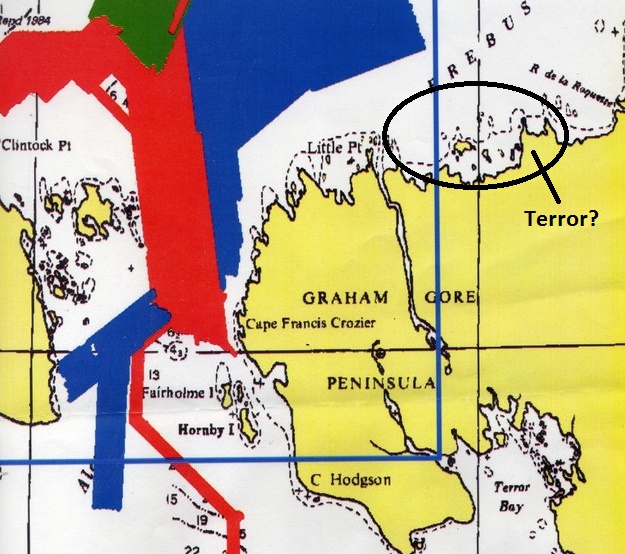
Fig. 1 Area surveyed by Parks Canada teams from 2011-13. The suggested search area is in the black oval.
